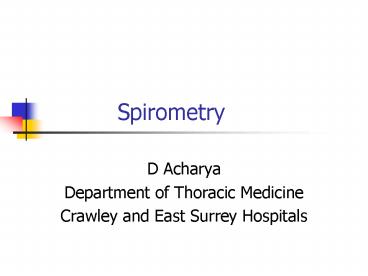Spirometry - PowerPoint PPT Presentation
1 / 9
Title: Spirometry
1
Spirometry
- D Acharya
- Department of Thoracic Medicine
- Crawley and East Surrey Hospitals
2
Measurements
- The manoeuvre involves the subject inspiring to
total lung capacity and then forcibly exhaling to
residual volume . - Four measurements are commonly made
- Total vol. exhaled when done slowly (VC)
- Total vol. exhaled when done rapidly (FVC)
- Volume of FVC exhaled in the 1st sec (FEV1)
- FEV1/FVC ratio
3
Equipment
- Calibrated spirometer
- Nose Clip
- Selection of mouth pieces
- Filters
- Technician with good motivational skills
- Printer
- Height scale, Predicted values
4
Procedures
- Entirely volitional exercise on the part of the
subject. - Maximum inspiratory effort followed by exhaling
completely (for at least six seconds) - Three times at a slow pace (VC)
- Followed by three times at a rapid pace (FVC and
FEV1 ).
5
Interpretation
- Comparison of values measured with values
expected based on age, height, sex and race of
the subject. - The range of normal VC or FVC is 82 to 118 of
predicted (SD of 9). If it is reduced it is
described as restrictive lung disease.
6
Interpretation (contd.)
- FEV1 is evaluated in comparison
- to the values predicted for age, height, sex and
race - and as a ratio of the FVC (FEV1/FVC)
- A reduced FEV1 (lt 80) and reduced FEV1/FVC ratio
(lt70) are features of obstructive lung disease.
7
Flow volume loops
- Additional information for evaluating airflow
limitation. - Expiratory flow volume loop helps diagnose small
airways asthma ( or FEF25-75) and distinguishes
between asthma (volume dependent airflow
limitation) and COPD (pressure dependent airflow
limitation). - Inspiratory flow volume loop helps investigate
extra-thoracic airways obstruction.
8
Peak Expiratory Flow Rate
- More dependent on appropriate voluntary effort
than spirometry. - High negative predictive value for airways
obstruction. - Low positive predictive value for airways
obstruction. - Good tool for self monitoring.
9
THANK YOU































